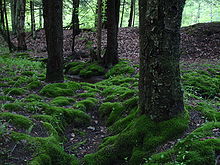
Back Mos Afrikaans نباتات حزازية Arabic نباتات حزازيه ARZ Bryophyta sensu stricto AST Mamırlar Azerbaijani Мүктәр Bashkir Laabmoos BAR Samanas BAT-SMG Імхі Byelorussian Листнати мъхове Bulgarian
| Moss | |
|---|---|

| |
| Clumps of moss on the ground and base of trees in the Allegheny National Forest, Pennsylvania, United States | |
| Scientific classification | |
| Kingdom: | Plantae |
| Clade: | Embryophytes |
| Clade: | Setaphyta |
| Division: | Bryophyta Schimp. sensu stricto |
| Classes[2] | |
| Synonyms | |
| |
Mosses are small, non-vascular flowerless plants in the taxonomic division Bryophyta (/braɪˈɒfətə/,[3] /ˌbraɪ.əˈfaɪtə/) sensu stricto. Bryophyta (sensu lato, Schimp. 1879[4]) may also refer to the parent group bryophytes, which comprise liverworts, mosses, and hornworts.[5] Mosses typically form dense green clumps or mats, often in damp or shady locations. The individual plants are usually composed of simple leaves that are generally only one cell thick, attached to a stem that may be branched or unbranched and has only a limited role in conducting water and nutrients. Although some species have conducting tissues, these are generally poorly developed and structurally different from similar tissue found in vascular plants.[6] Mosses do not have seeds and after fertilisation develop sporophytes with unbranched stalks topped with single capsules containing spores. They are typically 0.2–10 cm (0.1–3.9 in) tall, though some species are much larger. Dawsonia, the tallest moss in the world, can grow to 50 cm (20 in) in height. There are approximately 12,000 species.[2]
Mosses are commonly confused with liverworts, hornworts and lichens.[7] Although often described as non-vascular plants, many mosses have advanced vascular systems.[8][9] Like liverworts and hornworts, the haploid gametophyte generation of mosses is the dominant phase of the life cycle. This contrasts with the pattern in all vascular plants (seed plants and pteridophytes), where the diploid sporophyte generation is dominant. Lichens may superficially resemble mosses, and sometimes have common names that include the word "moss" (e.g., "reindeer moss" or "Iceland moss"), but they are fungal symbioses and not related to mosses.[7]: 3
The main commercial significance of mosses is as the main constituent of peat (mostly the genus Sphagnum), although they are also used for decorative purposes, such as in gardens and in the florist trade. Traditional uses of mosses included as insulation and for the ability to absorb liquids up to 20 times their weight. Moss is a keystone genus and benefits habitat restoration and reforestation.[10]
- ^ Hubers, M.; Kerp, H. (2012). "Oldest known mosses discovered in Mississippian (late Visean) strata of Germany". Geology. 40 (8): 755–58. Bibcode:2012Geo....40..755H. doi:10.1130/G33122.1.
- ^ a b Goffinet, Bernard; William R. Buck (2004). "Systematics of the Bryophyta (Mosses): From molecules to a revised classification". Monographs in Systematic Botany. Molecular Systematics of Bryophytes. Vol. 98. Missouri Botanical Garden Press. pp. 205–239. ISBN 978-1-930723-38-2.
- ^ "Bryophyta". Merriam-Webster.com Dictionary.
- ^ Schimper, W. P. (1879). "Bryophyta". In Zittel, K.A. (ed.). Handbuch der Palaeontologie. Vol. 2. R. Oldenbourg.
- ^ de Sousa, Filipe; et al. (2019). "Nuclear protein phylogenies support the monophyly of the three bryophyte groups (Bryophyta Schimp.)". New Phytologist. 222 (1): 565–75. doi:10.1111/nph.15587. hdl:1983/0b471d7e-ce54-4681-b791-1da305d9e53b. PMID 30411803. S2CID 53240320.
- ^ Ligrone, R.; Duckett, J.G.; Renzaglia, K.S. (2000). "Conducting tissues and phyletic relationships of bryophytes". Philos Trans R Soc Lond B Biol Sci. 355 (1398): 795–813. doi:10.1098/rstb.2000.0616. PMC 1692789. PMID 10905610.
- ^ a b Lichens of North America, Irwin M. Brodo, Sylvia Duran Sharnoff, ISBN 978-0-300-08249-4, 2001
- ^ Bell, N. E. & Hyvönen, J. (2010). "Phylogeny of the moss class Polytrichopsida (BRYOPHYTA): Generic-level structure and incongruent gene trees". Molecular Phylogenetics and Evolution. 55 (2): 381–398. doi:10.1016/j.ympev.2010.02.004. PMID 20152915.
- ^ Bodribb, T.J.; et al. (2020). "Advanced vascular function discovered in a widespread moss". Nature Plants. 6 (3): 273–279. doi:10.1038/s41477-020-0602-x. PMID 32170283. S2CID 212641738.
- ^ Rochefort, Line (2000). "Sphagnum: A Keystone Genus in Habitat Restoration". The Bryologist. 103 (3): 503–508. doi:10.1639/0007-2745(2000)103[0503:SAKGIH]2.0.CO;2. ISSN 0007-2745. JSTOR 3244138. S2CID 55699307.